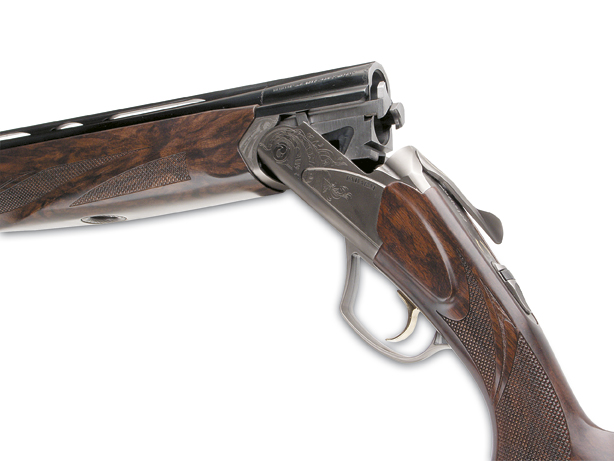Fabarm Axis shotgun review

Fabarm Axis shotgun review
Manufacturer: Fabarm
Fabarm Axis shotgun
Price: £1000-£1500
Mention Fabarm, and nowadays most shooters think of a soundly-designed semi-auto. Yet, 20 and more years ago, there was a well-priced over-under called the Gamma, which was a first gun for quite a large number of shooters.
In fact, there always have been good over-unders from the Italian manufacturer, the latest of which is the very modern-looking Axis, and we shall be looking at the 20-bore version. Incidentally, the Gamma II is still in production.
In looks the Axis follows a style set by the Browning Cynergy, although it is without the ‘back to front’ jointing system employed on the Browning gun. In fact, the 21st Century look is cosmetic, and inside the action are proven, reliable operating principles which have been part of the Fabarm design for decades.
The barrels, however, are something entirely different, as we shall discover, and so is the exterior finish on both metal and woodwork.
Who makes it?
It’s an abbreviation for Fabbrica Bresciana Armi, the direct descendant of one of the greatest gunsmith dynasties in Brescia, the Galesi Family, who have been in the arms business for over 400 years. Today, the modern Fabarm plant at Travagliato, just outside Brescia , is a magnificent blue glass edifice with a covered area of 10,000 square metres. As well as rifles, over-under, side-by-side and semi-auto sporting shotguns, they make specialist shotguns for law enforcement and military use – referred to as ‘alley-sweepers’ in some gung-ho American circles, we understand.
How adaptable is it?
This is a relatively lightweight gun, but is chambered and proofed for 3in magnum shells – including high-performance loads of steel, if you can find them in 20-bore. Most shooters would use it for game and clays, but all the options are open if you can stand the recoil.
How does it work?
One of the most interesting technical things about this gun is the metal finish applied to all the exterior metal parts except the barrels. It is called PVD titanium. PVD stands for Physical Vapour Deposition, in which vaporised titanium is bonded to the surface by a plasma process, creating a thin, hard, protective film on the surface.
Fabarm say that parts so coated have successfully emerged after 1,500 hours, that’s about three months, in a salt spray chamber. That’s some achievement when you consider that plain steel parts tested in such conditions of salt, heat and dampness can be showing signs of corrosion within a few hours. The finish would seem to be excellent for guns intended for coastal wildfowling.
The shapes of the action block, trigger guard and fore-end iron are unusual, too, with some apparently odd but quite pleasing lines and angles. Shape of the top lever is slightly unusual, too, but all the lines compliment each other, and the gun looks good.
An acid-etched pattern decorates the outside of the action, with the Fabarm lion logo in gold underneath, with some further gold engraving on the top strap ahead of the safety.
Inside, the action follows standard Fabarm practice, with hammers pivoting from the bottom and sears hanging from the top strap. The hammers are driven by coil mainsprings running on guide rods. When the trigger is pulled the sears are lifted from the bents in the hammers, but each hammer also has a second, safety bent so, if the gun suffers a sharp blow which might dislodge the sears, an accidental discharge is unlikely. A recoil-driven inertia mechanism transfers the trigger to the second barrel.
Initial barrel selection is by a rocking switch in the safety thumbpiece, and the safety itself is non-automatic.
The trigger is adjustable for sear clearance, and also in a fore and aft plane to suit the shooter’s hands. Trigger pulls are clean and crisp.
Barrels
– In front of the 3in chambers are very long forcing cones leading into a parallel area which is about ten thou overbored compared to normal 20-bore standards.
– Ahead of this parallel area is a very slight taper which finally leads into the multichoke tubes which are over three inches long and flush fitting. Fabarm say this boring system, which they call Tribore, gives superior shot penetration as well as better patterns. It should also reduce recoil.
– The barrel set (28in on the test gun, but the Fabarm website lists a selection between 24in – the legal minimum in the UK – up to 30in) is built on the monobloc system, with ventilated top and side ribs, the top rib tapering from 7mm down to 5mm. Bridges on the top rib are grouped together in pairs.
Woodwork
– Fabarm call their new stock finish Triwood, in which the wood is patterned with ink to simulate top-grade walnut, then coated with a semi-gloss acrylic varnish. Drawing grain patterns on walnut with ink is nothing new – British stockers have had the ability to do it for years – but the Fabarm process is a modern application which looks good, and the varnish provides good protection against dampness.
– Chequering is laser-cut, something which helps to give the stock and fore-end a comfortable, positive feel – and the stock terminates in a rubber butt pad with a smooth heel.
– The stock is 14½ inches long at the centre, with drops at comb and heel of 1½ and 2¼ inches respectively.
How heavy?
The test gun weighed 6½ lb.
What the tester thought
Sporting Gun tested the Axis in August 2005. It scored 8 out of 10 for build quality, styling and value for money, and 9 out of 10 for handling. High points were listed as the barrel boring, the inked figure on the stock and the chequering, and the multichoke system. The tester described it as a very interesting gun with a host of innovative features.
Price
Around £1,250.
More information
From the importers, Viking Arms, Summerbridge, Harrogate, Yorkshire. Tel: 01423 780810.








